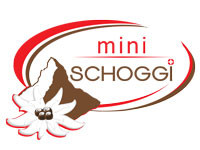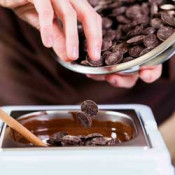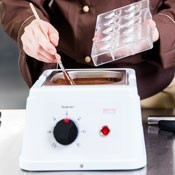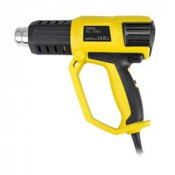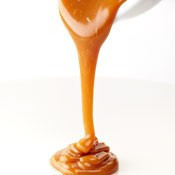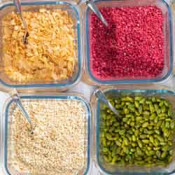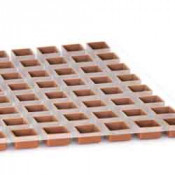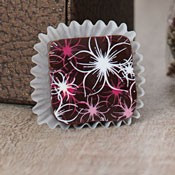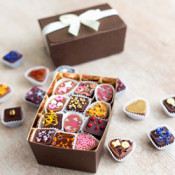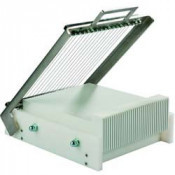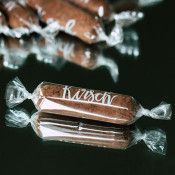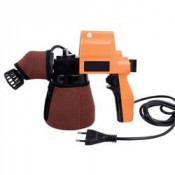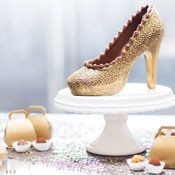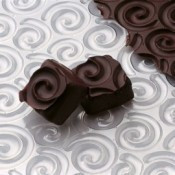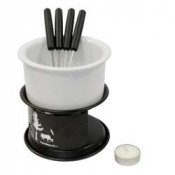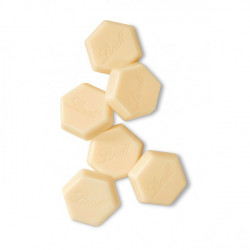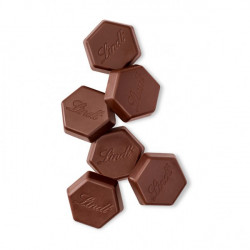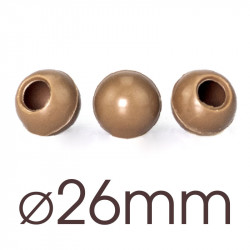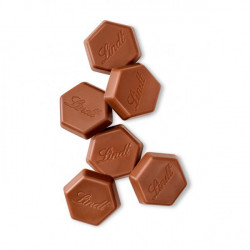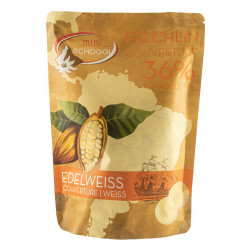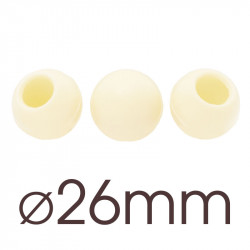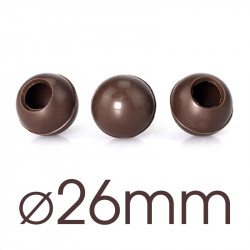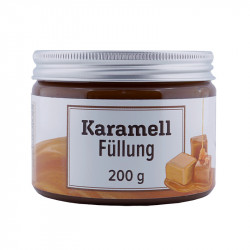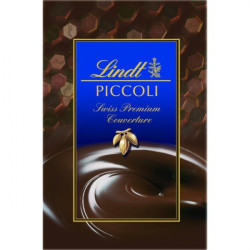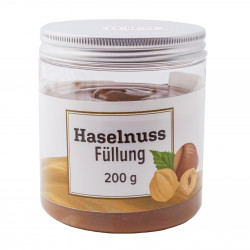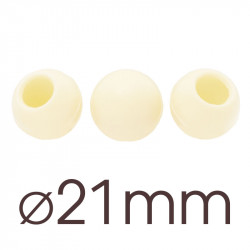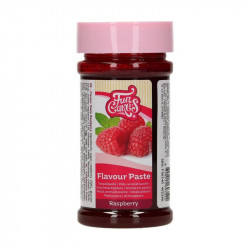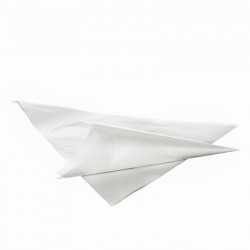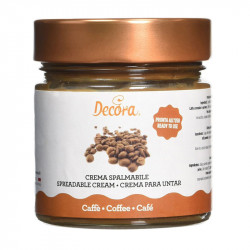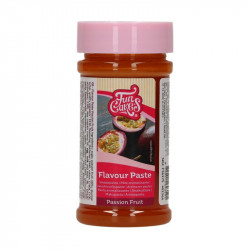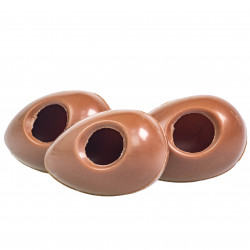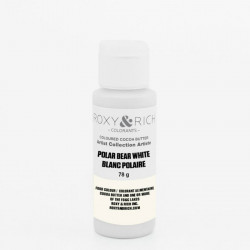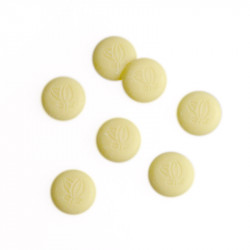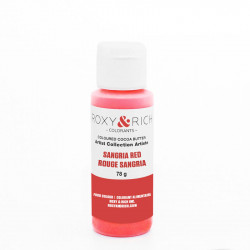Chocolate and pralines
Unterkategorien
What is chocolate good for?
Chocolate makes you happy! Of course, it is a fine delicacy in and of itself, but it is at least as good shaped and as an ingredient in various creations as it is in bar form! Typical examples of using chocolate are, of course, making your own chocolate bars and tablets, creative chocolate figures or melt-in-the-mouth pralines. Once you've got the hang of it, it's not that complicated. The most complicated part is always tempering to guarantee the right consistency and a great shine. However, this also gives the chocolate an attractive appearance in addition to its excellent flavor. It is also suitable for various decorations. It can be used to conjure up colored chocolate flakes, elegant spirals, impressive chocolate flowers or subtle zebra rolls. If you would like to find out more, we recommend our chocolate decorating course. Patisserie glazes with additional cocoa butter for more tenderness are also somewhat easier to make, and various biscuits are given the finishing touches by dipping or filleting. Thin-walled chocolate parcels or striped borders for cakes or patisserie pieces are very special, but also somewhat challenging.
Of course, chocolate doesn't just belong around chocolate, but also in it! It is the perfect ingredient for many cakes, it gives cakes an irresistible taste and chocolate buns are something for all ages. Even some savory dishes become something very special with chocolate.
What do I need for chocolate processing?
At miniSchoggi, we offer one of the largest online stores in Switzerland when it comes to the range of products for cooking, confectionery and baking projects. This variety is particularly evident in this category and can be a little overwhelming. If you're wondering what you need or could use all this stuff for, we've put together a small overview here. You can easily see what can help you with your project and find everything you need in no time at all.
Fillings and baking
Probably the easiest application is when you use chocolate baking drops to conjure up delicious pieces in your cake or make a cake filling from couverture and full cream. All you need to do is choose the right type of chocolate and you're ready to go. The same applies to covering cakes and desserts with cake melts / cake icing.
Fundamentals
In most cases, you don't need much to get started with chocolate processing, but a little basic equipment can come in handy. For example, you can almost always use a good rubber scraper and you can hardly avoid the right packaging if you want to create a beautiful gift. The type of packaging is completely individual, here you will find everything from Easter egg wrapping foil and chocolate boxes to cellophane bags for chocolate bars and hollow figures.
Tempering is also a big issue. At this point, it should be mentioned that couverture must be used for all glossy and self-poured creations. You can find out more about this below. A thermometer is also essential, so that you can always check the correct temperature or make any necessary adjustments to achieve the perfect, ready-to-use mixture at the end.
Other aids are the temperature control unit and the hairdryer. They are not absolutely necessary, but they make the process faster and, unlike the water bath, the temperature control unit does not need to be constantly supervised.
Chocolates
Chocolates are incredibly sophisticated and yet so easy to make yourself. However, some production methods are only suitable for advanced or experienced amateur chocolatiers.
Truffles can be made by anyone. This requires hollow balls, i.e. still unfilled round chocolate shells. Shaped chocolates with praline molds are a little more challenging but still easy to make. These are made of polycarbonate and can be painted with cocoa butter paint before filling. They are then brushed with a silicone brush and filled by pouring or using a piping bag. The remaining chocolate is poured out again; a chocolate hammer can help here, or alternatively a rubber spatula can be used. Use the metal horn to clean the mold before placing it in the fridge.
The hollow shells, whether bought or homemade, are then filled with delicious ganache using a piping bag. You can also find these and other ingredients in the online store. After a little resting time, the shells are sealed with the help of cornet paper and a little couverture. Truffles can then be coated with a little couverture and rolled in coconut flakes or similar, for which we recommend wearing hygiene gloves.
There are also cut chocolates, for which solid layers are made, for example from ganache and marzipan. Cutting is done with a sharp knife and a kind of ruler; if you like it simple or produce a lot, a cutting harp is recommended. The pieces are then stamped with a stamping fork, i.e. coated with chocolate. Spritzpralinen also require a slightly firmer ganache, which is piped onto a chocolate drop using a piping bag and large nozzle and also stamped.
The pinnacle of chocolate making is definitely working with the powder box to make delicious cherry sticks. This requires a lot of skill and prior knowledge. You will also need a powder box, suitable shapers, a sugar thermometer and a syrup density meter. You should also have a piping fork and a draining rack.
For handmade chocolates, we have various chocolate boxes, bags and chocolate capsules. Colored aluminum foil can also be used as a wrapper. So if you want to make your own chocolates and give them to someone as a gift, you will find the right packaging here.
Chocolate bars
The materials for chocolate bars are almost the same as for praline molding. You will also need a silicone brush and a metal horn, but you will now need a chocolate bar mold. A piping bag and chocolate hammer are useful tools. Colored cocoa butter, crunchy pearls or sprinkles can be used for elegant decorations. Some chocolate molds are also suitable for filled treats. The finished treats can be packaged in colored aluminum foil or transparent bags of the appropriate size as gifts.
Hollow figures
Hollow figures are also filled with the best couverture. Beforehand, great details can be painted on with fine brushes and colored cocoa butter. The mold is then brushed with a silicone brush, clamped together and filled. The best way to knock out air bubbles is with a chocolate hammer, then the remaining chocolate is poured out. Use a metal horn to clean the edges and after a short cooling time, make a thin base. To do this, spread couverture on a sheet of baking paper with a spatula and press the mold into it. Then cool again and the figure can be removed and nicely wrapped.
Decorations
Chocolate decorations are particularly versatile and absolutely delicious - both figuratively and literally. Of course, it is important to have a well-tempered couverture, which is then shaped and cooled. Decorative molds can be used for this, the procedure is the same as for a very thin chocolate bar. However, you will need a suitable base for most decorations; food-safe foil or cake insert strips are suitable for this. There are also chocolate tattoos made from cocoa butter and textured foils, so you can easily create beautiful little plates.
If the aim is to create an elegant spiral, a striped pattern or sticks, a chocolate comb is used. Spatulas or a metal horn also help to spread the chocolate thinly. Leaf spatulas can be used to conjure up pretty shapes, and to make them look a little more lively like leaves, they can be placed on a baguette tray with the foil. If they are firm, they will keep their nice round shape.
How do I make high-quality chocolate myself?
Making your own delicious chocolate to your own taste - a dream that can come true. On our Bean to Bar course, you can get creative and make your own couverture. You will also receive all the information you need to make other creations at home, but you will need a few machines to do so. You can also buy these from us online, but they are professional machines that are not cheap. That's why it's worth learning and trying out everything on site.
The chocolate-making process begins with the selection of the cocoa beans. These are already roasted and available as whole beans or nibs. Origin and processing have a major influence, for example the soil can affect the acidity, and the roasting leads to different aromas. They are ground together with other ingredients in the melangeur and processed for several hours to turn the grainy mass into a melt-in-the-mouth delight.
Tempering promotes the formation of the preferred fat crystals. This makes the chocolate meltable again and again, giving it a beautiful sheen and a crunchy break. Poured into bars, pralines or drops, the high-quality delicacy is ready for packaging
How is fine chocolate made?
The production of all chocolate products begins long before the beans are ground, namely on the plantation. Cocoa plants are small trees and their height, growth habit and taste depend heavily on the variety. There are hundreds of species, some are widespread and can be found in many commercially available products, others are real rarities. The trees like to grow in partial shade and bear fruit all year round. Flowers are also always to be found. Both grow directly from the trunk and branches, and buds, flowers, tiny and large ripe fruits can always be found on a single plant. Depending on the variety, the pods turn red, yellow or orange when they are ripe. They are then harvested by hand with a machete or a lance.
The elongated pod is cracked open, the seeds wrapped in white pulp are removed and stored in boxes, vats or on banana leaves. Over the next few days, they are repeatedly shifted around so that they ferment evenly. This is followed by the drying process. The cleaned beans are laid out and dried for several days. In rainy areas, they are often moved back and forth on rolling grids between the sun and the rain canopy. With a residual moisture content of just a few percent, they are then ready to be packed in bags and transported all over the world. They are then often checked for quality in the destination country, roasted and separated into cocoa mass and butter. The latter is one of the most expensive vegetable fats and is very popular both in the food industry and in cosmetics. For the ready-to-use chocolate, cocoa mass and butter are mixed with sugar, processed pulp, spices, milk powder and much more, depending on the recipe. This is how wonderful chocolate specialties are created from the inconspicuous beans of the colorful cocoa pods.
Chocolate or couverture: Which is better for confectionery recipes and creations?
When baking or preparing an airy chocolate mousse, standard chocolate bars can be used to a large extent. As it is not absolutely necessary for the pure chocolate to appear as a shiny layer in the end product, it is irrelevant whether it has been correctly heated and cooled again. The texture of the chocolate mixture is often not a decisive factor either, so chocolate bars can be a cost-effective option here.
However, when it comes to depositing and filling pralines, homemade chocolate bars or even a chocolate bunny, couverture is essential. It is ideal for depositing fine confectionery, as it flows well and then achieves a perfect sheen. The use of conventional chocolate would result in a significant loss of appearance and taste, and it is often difficult to remove the hardened mass from the polycarbonate molds. In such cases, it unfortunately has to be melted out with hot water.
It is therefore advisable: If you want to make cakes with chocolate chips or a simple mousse, you can also use chocolate bars. However, it is important to use couverture when making luxurious pralines, melt-in-the-mouth ganache or glossy coatings.
How is chocolate tempered?
Here we explain how to temper and process couverture correctly to achieve a glossy and crispy result. We also explain how you can use the inoculation method in your own kitchen. You can find more tips on tempering on our blog, and if you would like to try it out under supervision, we recommend our tempering course.
The simplest of all tempering methods is the seeding method. It consists of adding stable crystals in the form of fresh couverture drops to the melted mass. First, two thirds of the required couverture is melted at 45 °C to dissolve all the fat crystals. Once the mixture has cooled and fresh couverture has been added, new stable crystals can form. Stirring dissolves the pieces and distributes them evenly throughout the warm mixture.
This is why this technique is known as the seeding method. Cold, solid couverture pieces with stable crystals are added to a liquid couverture that does not yet contain any stable fat crystals in order to "inoculate" it. This cools the mass down to 26 to 28 degrees.
Although it is helpful to have a tempering device available, it is not absolutely necessary. In our online store, you can order various temperature control units, from models for home use to professional devices, for convenient delivery to your home. These appliances make the process easier as they keep the desired temperature constant. This allows you to concentrate fully on making delicious chocolate products.
It is also very easy to heat the chocolate mass over a water bath, but you should always keep an eye on the thermometer.
Order ingredients for pralines and truffles online
Can you order ingredients for chocolate and pralines online? Don't worry, even the most delicate items will arrive safely at your home. Order in the online store and have them delivered to your home easily and conveniently. The parcels are carefully packed by our team so that nothing is crushed or flies around during transportation. The most delicate items are probably hollow balls and hollow shells, which are packed extra sturdily and well-padded in a box. This means that we can also send them with a clear conscience. For all chocolatiers who want to make delicious pralines and chocolate in summer, we have another option. The high temperatures can damage the couverture and the hollow shells in the parcel, for example if it has to wait in a post bus that is heating up. That's why we hold back consignments containing chocolate products on Fridays. That way, they only leave the refrigerated warehouse after the weekend. The same applies to particularly hot days. If you need the products as soon as possible, you can order refrigerated shipping for the chocolate and pralines.
